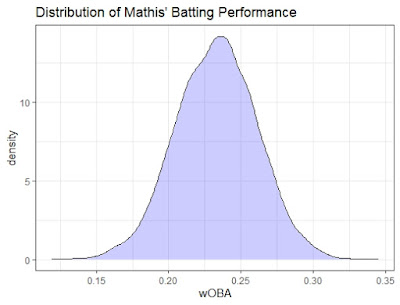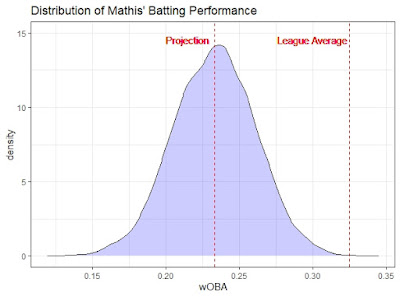Jeff Mathis is not a great hitter. He is not a good hitter.
In fact, he is a bad hitter. Jeff Mathis has a career wOBA of 0.244 in 2,938
plate appearances. To put that into context, he is one of only five players
since integration in 1947 to have a career wOBA less than 0.250 in at least 2,500
plate appearances (excluding pitchers). The only players with 2,500 career plate
appearances that have performed worse are Hal Lanier (0.238 in 3940 plate
appearances from 1964 to 1973) and Rafael Belliard (0.241 in 2524 plate
appearances from 1982 to 1998). Since the turn of the century, just one player with
2,500 plate appearances is within 10% of Mathis (John McDonald).
Mathis’ exploits as a catcher have allowed him to stay on
the field throughout his career. He has been worth 132.8 runs of value over the
course of his career (per FanGraphs). However, one may argue that his defensive
ability is not such where he has warranted consistent playing time for over
decade. Despite his defensive ability, he has been worth 3.6 fWAR in his
career. This is just about 0.8 WAR per 650 plate appearances, barely above replacement
level performance with a starting level player number of plate appearances.
When you account for the fact that catchers play less than the other positions
around the diamond, the rate of value provided is even worse. Taking the
catcher with the 15th most plate appearances in 2019 (as a proxy for
an average starter) and you get 0.48 WAR over the course of a full season’s worth
of a starting catcher’s workload. And this quick arithmetic is based on his
career average of WAR per plate appearance, not adjusted for age. Last year
Mathis was worth -2.1 WAR over just 244 plate appearances.
So, as I said from the jump, Jeff Mathis has demonstrated repeatedly
that he is not a great major league hitter. Thus, his Depth Charts wOBA projection
(via FanGraphs) for the 2020 season is just 0.233, the lowest of any regular
position player. The projection, however, is just the most likely value in his
entire distribution of expected outcomes. Projection systems try to pinpoint a player’s
“true talent”. But we know that given a player’s statistics in a given season,
game, or plate appearance is just one value of many possibilities. What I
looked to tackle is how often, if we simulated Mathis’ 2020 season repeatedly,
would he be an average hitter, a feat he has yet to accomplish in his career.
Last year, the league average for non-pitcher wOBA was 0.325. I simulated 211 Jeff
Mathis plate appearances (his projected playing time by the Depth Charts
projections over at FanGraphs) 10,000 times. I yielded the following results:
But where do his projection and league average fall on this
distribution?
Clearly, we should expect Mathis to post a batting line
about 30% worse than league average. But there is hope! In 0.6% of the
simulations (six out of 10,000) he posts a league average batting over 211
plate appearances. So, is Jeff Mathis a league average hitter? He most certainly
is not. But can he post a league average batting line? Maybe but probably not! Given
only 211 plate appearances, there is room for variance to guide Mathis to the
promise land. Now, if Mathis accrues more plate appearances, we should expect
his batting line to more closely mirror his true talent. So how does his
distribution of outcomes change if he receives an average starting catcher’s
amount of plate appearances (which we will set at 391 plate appearances based
on last year)?
Not surprisingly the distribution tightens with the addition of
180 plate appearances. When simulating seasons with 391 plate appearances, Mathis
does not reach a league average batting line once. And just for fun and some
additional context, lets compare the range of possible outcomes for 650 plate
appearances of Jeff Mathis and 650 plate appearances of Mike Trout, who is
projected for a 0.427 wOBA by the Depth Charts projection system:
So, Jeff Mathis is not as prolific a hitter as Mike Trout.
Who would have known? All joking aside, my main takeaway is that for as poor a
hitter as Jeff Mathis has been throughout his career, given few enough plate
appearances, he can post a league average batting line. This should give some
insight into the difference between talent or a projection versus the range of
possible outcomes. Would Jeff Mathis be a league average hitter over 211 plate
appearances? The answer, as strange as it sounds, is possibly.




No comments:
Post a Comment